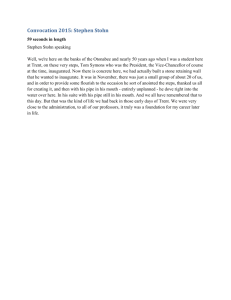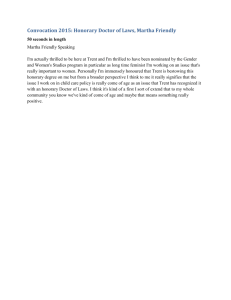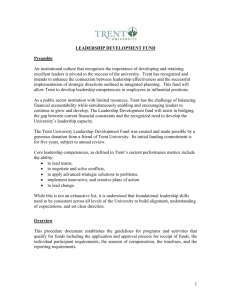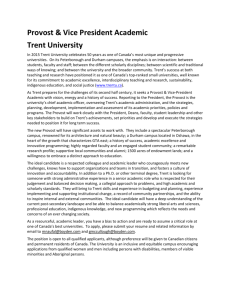Land South West Of Attenborough Nature Reserve, Barton Lane
advertisement
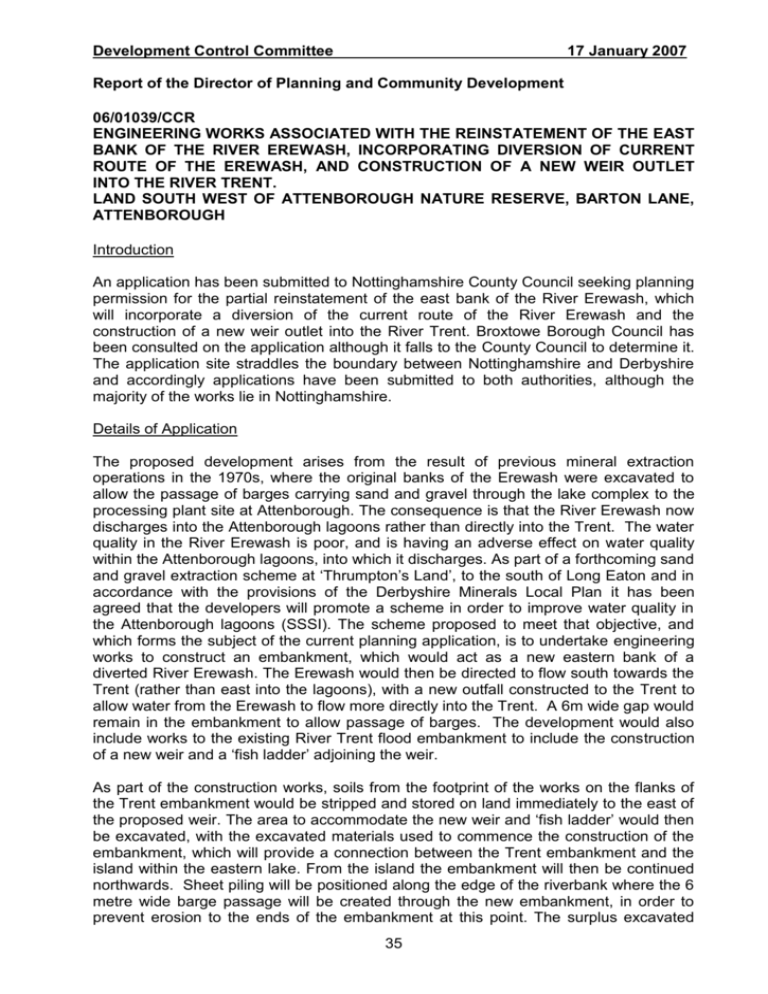
Development Control Committee 17 January 2007 Report of the Director of Planning and Community Development 06/01039/CCR ENGINEERING WORKS ASSOCIATED WITH THE REINSTATEMENT OF THE EAST BANK OF THE RIVER EREWASH, INCORPORATING DIVERSION OF CURRENT ROUTE OF THE EREWASH, AND CONSTRUCTION OF A NEW WEIR OUTLET INTO THE RIVER TRENT. LAND SOUTH WEST OF ATTENBOROUGH NATURE RESERVE, BARTON LANE, ATTENBOROUGH Introduction An application has been submitted to Nottinghamshire County Council seeking planning permission for the partial reinstatement of the east bank of the River Erewash, which will incorporate a diversion of the current route of the River Erewash and the construction of a new weir outlet into the River Trent. Broxtowe Borough Council has been consulted on the application although it falls to the County Council to determine it. The application site straddles the boundary between Nottinghamshire and Derbyshire and accordingly applications have been submitted to both authorities, although the majority of the works lie in Nottinghamshire. Details of Application The proposed development arises from the result of previous mineral extraction operations in the 1970s, where the original banks of the Erewash were excavated to allow the passage of barges carrying sand and gravel through the lake complex to the processing plant site at Attenborough. The consequence is that the River Erewash now discharges into the Attenborough lagoons rather than directly into the Trent. The water quality in the River Erewash is poor, and is having an adverse effect on water quality within the Attenborough lagoons, into which it discharges. As part of a forthcoming sand and gravel extraction scheme at ‘Thrumpton’s Land’, to the south of Long Eaton and in accordance with the provisions of the Derbyshire Minerals Local Plan it has been agreed that the developers will promote a scheme in order to improve water quality in the Attenborough lagoons (SSSI). The scheme proposed to meet that objective, and which forms the subject of the current planning application, is to undertake engineering works to construct an embankment, which would act as a new eastern bank of a diverted River Erewash. The Erewash would then be directed to flow south towards the Trent (rather than east into the lagoons), with a new outfall constructed to the Trent to allow water from the Erewash to flow more directly into the Trent. A 6m wide gap would remain in the embankment to allow passage of barges. The development would also include works to the existing River Trent flood embankment to include the construction of a new weir and a ‘fish ladder’ adjoining the weir. As part of the construction works, soils from the footprint of the works on the flanks of the Trent embankment would be stripped and stored on land immediately to the east of the proposed weir. The area to accommodate the new weir and ‘fish ladder’ would then be excavated, with the excavated materials used to commence the construction of the embankment, which will provide a connection between the Trent embankment and the island within the eastern lake. From the island the embankment will then be continued northwards. Sheet piling will be positioned along the edge of the riverbank where the 6 metre wide barge passage will be created through the new embankment, in order to prevent erosion to the ends of the embankment at this point. The surplus excavated 35 Development Control Committee 17 January 2007 material from the new cutting to create the southern diverted Erewash channel would be used to create an embankment across the existing outfall of the Erewash into the eastern lagoon, thereby directing the flow along the new route. Once this work has been completed the existing weir from the western lagoon to the River Trent would be closed. The final works would involve landscape treatment of the new embankment, which would aim to replicate the natural regeneration of scrub woodland. The attached plan shows the proposed works. Site History Gravel extraction in the Attenborough area has been taking place since the 1920s. Workings have moved progressively westwards, and in 1970, the Erewash was breached to permit barge transport of minerals excavated to the west of the river (in Derbyshire) to be transported back to Attenborough for processing. In 2005, Derbyshire County Council resolved to grant permission to extend the sand and gravel extraction further to the west into an area known as ‘Thrumpton’s Land’, which is to the south of Long Eaton. The development will involve the continued use of the barges to transport the minerals from Thrumpton’s Land to the existing processing plant site at Long Lane, Attenborough. The decision was subject to the completion of a section 106 agreement, which is intended, among other things, to protect the water quality of the SSSI and the amenity of local residents who live near the processing plant. The company previously proposed a ‘siphon’, which would take the relatively polluted water of the River Erewash under the ‘ponds’ in the SSSI before it flowed into the River Trent. The draft agreement was however altered in September 2006 and, instead of the ’siphon’, it now proposes the partial reinstatement of the east banks of the River Erewash as a means of protecting the water quality in the SSSI. The ‘siphon’ proposal was reconsidered due to the cost of construction and concerns by the Environment Agency that this could lead to additional flooding. The applicants maintain that the proposed re-instatement of the embankment will not only protect the environment but would also reduce the potential concerns of flooding. Nottinghamshire County Council has undertaken extensive discussions with Natural England and the Environment Agency prior to submission of the application. As planning authority, it will take into account the advice of these and other bodies, before determining the proposal. Planning Policies The site lies in the green belt. Local Plan Policy E8 states that planning permission will only be granted where it constitutes appropriate development. The defined categories of appropriate development include “essential facilities for cemeteries and other uses of land which preserve the openness of the green belt and which do not conflict with the purposes of including land within it”, and “mineral working subject to high environmental standards and a high standard of restoration”. Policy E9 states that appropriate development in the green belt will itself not be permitted if it would harm the open character or visual amenities of the green belt. The site lies in the Attenborough Nature Reserve Site of Special Scientific Interest (SSSI). Local Plan Policy E15 states that planning permission will not be granted for development which would have an adverse effect on the SSSI except in exceptional circumstances. Policy E16 states that where there are special reasons for permitting 36 Development Control Committee 17 January 2007 development in areas of nature conservation interest, the applicant shall minimise harm to the site’s features and compensate for the loss of any special features of interest. Policy E28 states that planning permission will not be granted for development within areas of high flood risk which would increase the risk of flooding. The recent Natural Environment and Rural Communities Act 2006 has imposed a duty on public authorities in exercising their functions to have regard to the purpose of conserving bio diversity. Appraisal The role of Broxtowe Borough Council is to provide a consultation response to Nottinghamshire County Council on the application. This Council has the opportunity to raise any concerns or issues, which it considers should be taken into account by the County Council, along with advice from statutory consultees and other interested parties. The main issues for consideration relate to impact on the green belt and SSSI, and to the protection of the water quality in the SSSI and the visual impact of the works. The site lies within the green belt and the Attenborough Nature Reserve SSSI where policies seek to protect the area from inappropriate or damaging development. Whilst it will be for the County Council to determine whether this development is appropriate in green belt terms, I am satisfied that it could fall within the categories of acceptable development set out in the local plan policies, provided that there is no harm to the openness of the area, the value of the nature conservation interest or the visual amenities of the area. An Environmental Impact Assessment (EIA) has been submitted with the application. This expands on how the water quality in the Attenborough lagoons (lake system) will be improved with the reinstatement of the eastern bank. Water in the River Erewash is contaminated with phosphates and nitrates, which are resulting in the development of algal blooms in the lagoons and deterioration in water quality. Concerns have previously been raised by Natural England and others regarding the quality of the water in the Attenborough Lagoons. It is anticipated that the volume of water entering the Attenborough lagoons would be reduced to some 6% of current flows, with 94% of flow directed to the western lakes (ie in Derbyshire) and the River Trent. Currently 100% of the water flow from the River Erewash enters the Attenborough lagoons. By reducing the flow of the River Erewash into the Attenborough lagoons, there will be a reduction in the pollutant load entering, including a reduction in the levels of nitrates and phosphates, which is likely to reduce the risk of excessive algal bloom developing in the Attenborough lagoons. It is therefore considered that the water quality of Attenborough lagoons (SSSI) will be improved with the proposed bank reinstatement. With regard to the issue of flooding the findings of the EIA state that the proposed embankment will not increase the frequency, duration or depth of flooding associated with the lagoons (lake system). The flood risk associated with the lagoons arises from flood flows either from the River Erewash or the River Trent. At present, all the flow in the River Erewash enters the lagoons. When high flows occur in the lower part of the Erewash then water levels in the lake rise until they discharge from the lagoons into the Trent. During extreme flood events on the River Trent, the water levels in the Trent exceed the levels of the bund around the lagoons and they are flooded. In this situation the flood levels in the River Trent determine the water levels in the lagoons. The report 37 Development Control Committee 17 January 2007 concludes that, with the east bank reinstatement, the water levels in the Erewash and the lagoon system would be no greater than they are at present and that there would be no adverse effect on flood levels in the lagoons. With regard to the effects on the character and appearance of the area, the applicants state that the works and the new features will not be generally visible from the surrounding landscape, apart from along a short stretch of the Trent Valley Way and Trent side opposite the location of the proposed weir, where there will be open views of the works under construction, and of the features after construction. The EIA report confirms that there will be some substantial adverse visual impact during construction, with little opportunity for mitigation. After construction, the weir feature will be a focal point in the view across the river and from the Trent Valley Way but the EIA report concludes that careful attention to the visual quality of the structure would mitigate adverse effects on landscape character and visual amenity. It considers that this is a “made” landscape and, based upon the opportunity to reproduce the character of the landscape in the new work, the long term effects of the proposed development on visual amenity would be neutral. The proposed works are likely to have some effect on local wildlife and vegetation in the immediate vicinity of the application site. Whilst there are proposed safeguards to minimise the potential impacts on species and their habitats, the overall direct effect of the development would be small scale and temporary. Moreover any local effects should be out-weighed by the significant improvement in water quality in the Attenborough Gravel pits SSSI, with consequential benefits to bio diversity, including a wider range of aquatic flora and fauna throughout the nature reserve. In addition, this part of the riverside is fairly bleak at present and the opportunity should be taken through this development to enhance the appearance of the area as well as its nature conservation value. In conclusion, it is considered that the proposed works incorporating the reinstatement of the east bank of the river Erewash, the diversion of current route, and construction of a new weir outlet into the River Trent, should significantly benefit the SSSI, whilst having limited impact on the appearance of this part of the Trent Valley. The County Council will need to be satisfied based on expert advice they receive in response to consultations (a) that the proposed works are technically achievable and would be likely to improve water quality for the lagoons in the Attenborough SSSI, (b) that there will be no increased flooding to the area, (c) that there will be no detrimental impact on the character or appearance of the area, with every opportunity taken to enhance the appearance and nature conservation value in the vicinity and d) that there will be an overall benefit for bio diversity throughout the nature reserve and SSSI. Subject to those provisos, it is recommended that this Council raises no objection to the scheme. Recommendation The committee is asked to RESOLVE to raise no objection to the application providing that Nottinghamshire County Council is satisfied (a) that the proposal is likely to successfully improve water quality for the Attenborough SSSI, (b) will result in no increased risk of flooding for the area (c) that every opportunity has been taken to minimise the effects on the appearance of the site and to enhance the nature conservation value and appearance in the vicinity of the works and (d) that there will be benefit for bio diversity throughout the nature reserve and SSSI. Background papers - Nil 38 Development Control Committee 17 January 2007 Site of Application Engineering works associated with the reinstatement of the east bank of the River Erewash, incorporating diversion of current route of the Erewash, and construction of a new weir outlet into the River Trent Land south west of Attenborough Nature Reserve, Barton Lane, Attenborough Development Control Committee 14 January 2007 Scale: 1: 10,000 Directorate of Planning & Community Development: Director P. M. Stone 39 N Development Control Committee 17 January 2007 New embankments New channel cutting NOTTINGHAMSHIRE DERBYSHIRE New outfall/sluice 40
